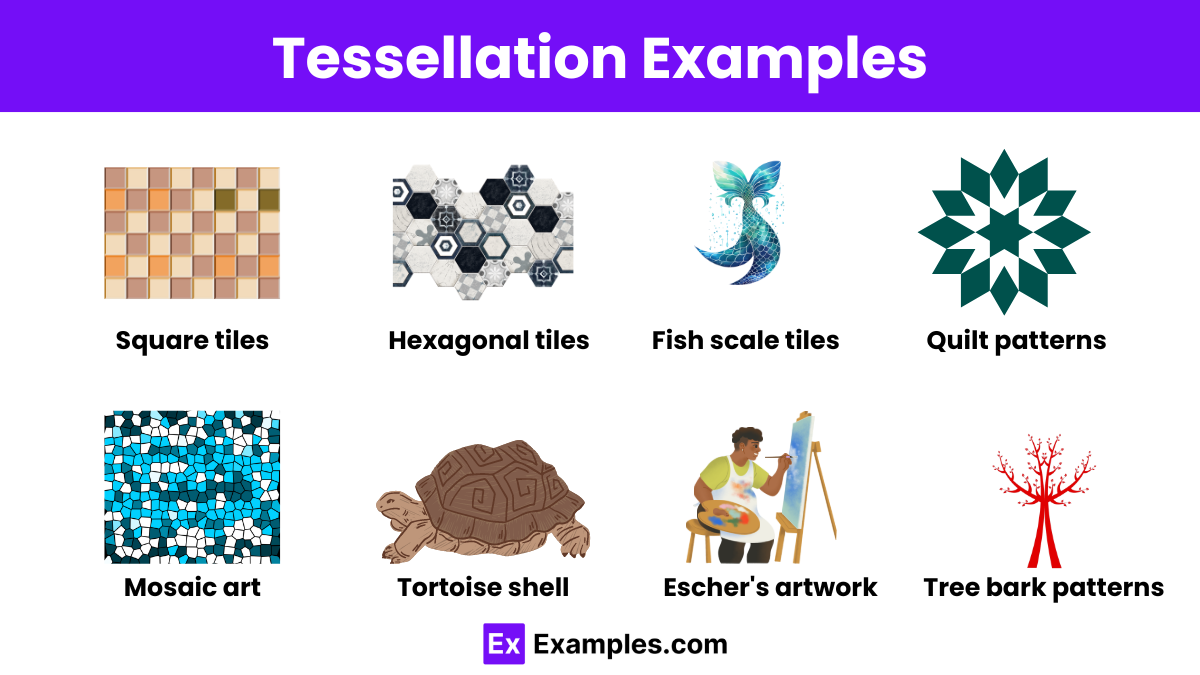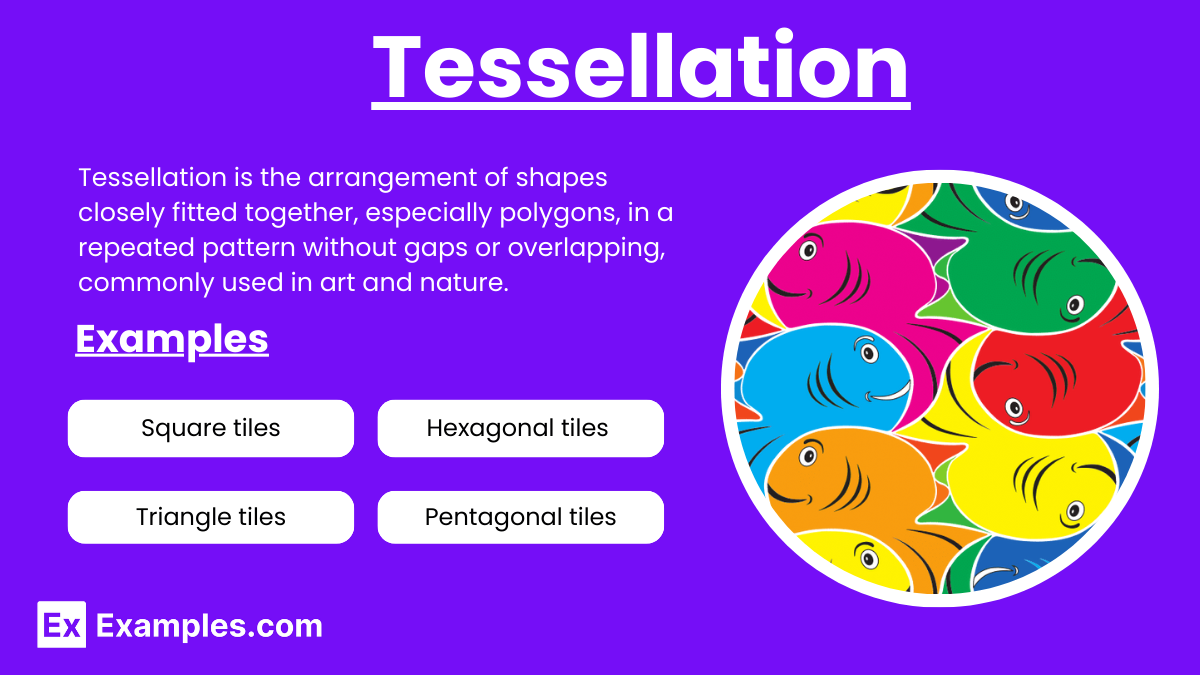21+ Tessellation Examples
Tessellation is the process of creating a pattern using the repetition of shapes without gaps or overlaps. In the context of artificial intelligence, tessellation can be used to analyze and recognize patterns in images and data. AI algorithms can leverage tessellation techniques to segment and interpret visual information, aiding in tasks such as image recognition, computer vision, and spatial analysis. By breaking down complex images into simpler, repeated shapes, AI can more effectively process and understand visual data.
What is tessellation?
Tessellation is the process of covering a surface with a pattern of shapes so that there are no gaps or overlaps. It involves repeating geometric shapes to create a continuous, interlocking design, often used in art, architecture, and mathematics.
Tessellation Examples

- Square tiles – Square tiles fit together perfectly without gaps or overlaps, creating a uniform tessellation pattern.
- Hexagonal tiles – Hexagonal tiles create a honeycomb pattern, providing a seamless and efficient tessellation.
- Triangle tiles – Equilateral triangles fit together in a repeating pattern, forming a consistent tessellation.
- Pentagonal tiles – Some types of pentagons can tessellate, forming interesting and complex patterns.
- Brick wall pattern – Rectangles arranged in a staggered pattern create a tessellation resembling a brick wall.
- Checkerboard pattern – Alternating squares create a classic tessellation found in checkerboards and chessboards.
- Fish scale tiles – Overlapping semi-circles form a fish scale pattern, creating an intricate tessellation.
- Celtic knot designs – Interwoven patterns in Celtic knots create a continuous, repeating tessellation.
- Escher’s artwork – M.C. Escher’s artwork features intricate, mathematically inspired tessellations.
- Islamic geometric patterns – Traditional Islamic art often uses tessellation with complex geometric shapes.
- Herringbone pattern – Rectangles arranged at right angles create a dynamic tessellation in flooring designs.
- Basket weave pattern – Interlocking rectangles form a woven appearance, creating a tessellated pattern.
- Mosaic art – Small, colored tiles arranged in patterns create detailed tessellated artwork.
- Quilt patterns – Repeating shapes and blocks in quilts form tessellated designs.
- Pineapple skin – The repeating pattern of pineapple skin is a natural example of tessellation.
- Beehive structure – Hexagonal cells in a beehive create a natural tessellation.
- Tortoise shell – The interconnected shapes on a tortoise shell form a natural tessellation pattern.
- Soccer ball design – Hexagons and pentagons on a soccer ball create a tessellated surface.
- Cobbled streets – Cobblestones arranged in patterns form tessellated streets and paths.
- Pavement patterns – Interlocking paving stones create tessellated walkways and driveways.
- Snowflake crystals – The intricate, repeating patterns in snowflakes form natural tessellations.
- Tree bark patterns – Some tree barks exhibit repeating, tessellated patterns in their texture.
Types of Tessellations
- Regular Tessellation: Uses one type of regular polygon; all angles and sides are equal.
- Semi-Regular Tessellation: Combines two or more types of regular polygons.
- Demiregular Tessellation: Uses multiple types of polygons in a more complex pattern.
- Non-Regular Tessellation: Uses irregular polygons to fill the plane.
- Translational Tessellation: Shapes are translated (slid) across the plane.
- Reflective Tessellation: Shapes are reflected (flipped) to create the pattern.
Importance of Tessellation
- Efficient use of space – Tessellation allows for the complete coverage of a surface without gaps or overlaps, maximizing space utilization.
- Structural stability – Patterns created by tessellation can distribute weight and stress evenly, enhancing the structural integrity of materials and designs, reflecting the intricate craftsmanship found in various ethnicities.
- Aesthetic appeal – Tessellated patterns are visually appealing and are commonly used in art, architecture, and design to create intricate and harmonious visuals.
- Mathematical applications – Tessellation is used in mathematics to study geometric properties and relationships, contributing to fields like topology and computational geometry.
- Real-world problem solving – Tessellation principles are applied in various industries, such as tiling, flooring, and materials science, to create efficient and effective designs.
- Natural phenomena understanding – Studying natural tessellations, like honeycombs and crystal structures, helps scientists understand biological and geological processes, performing crucial acts of service in scientific research.
Tessellation in Nature
- Honeycomb – Bees create hexagonal cells in honeycombs, using tessellation to achieve the objective of efficiently using space and resources.
- Pineapple skin – The repeating hexagonal pattern on a pineapple’s skin demonstrates natural tessellation for protection and structure.
- Tortoise shell – The interconnected shapes on a tortoise shell form a natural tessellation, providing strength and protection.
- Snake scales – The overlapping scales of snakes form a tessellated pattern, aiding in flexibility and protection.
- Fish scales – Fish scales overlap in a tessellated pattern, showcasing characteristics that allow for smooth movement and protection from predators.
- Leaf venation – The network of veins in leaves forms a tessellated pattern, optimizing nutrient and water distribution.
- Crystals – Natural crystals form tessellated patterns at the molecular level, creating repeating geometric shapes.
- Spider webs – The radial and spiral patterns in spider webs demonstrate tessellation, optimizing strength and capture efficiency.
Three Rules for Tessellations
- The tessellation must cover a plane without gaps or overlaps: The shapes must fit together perfectly to fill the entire space.
- The tessellation must use a repeating pattern: The same shape or set of shapes must be repeated throughout the design.
- Each vertex where the shapes meet must be identical: The angles at which shapes meet must be the same at every vertex, ensuring uniformity.
Which Shapes Cannot Tessellate?
- Circles: Their curved edges create gaps between each other, preventing a seamless fit.
- Ovals: Like circles, their non-angular edges leave spaces when arranged together.
- Pentagons (regular): Regular pentagons have angles that do not allow them to fit together without gaps.
- Heptagons: The seven sides and angles do not allow for gapless tiling.
- Octagons: Regular octagons create gaps unless combined with other shapes like squares.
- Irregular Polygons with No Equal Angles: Shapes without consistent angles cannot form a repeating, gapless pattern.
Tessellation Shapes
- Squares: Four equal sides and angles allow them to fit together perfectly.
- Equilateral Triangles: Three equal sides and angles can tile the plane without gaps.
- Regular Hexagons: Six equal sides and angles fit together seamlessly.
- Parallelograms: Opposite sides are equal and parallel, making them fit together without gaps.
- Rectangles: Opposite sides are equal, and right angles ensure they tessellate perfectly.
- Rhombuses: Four equal sides with opposite equal angles can tile the plane.
Advantages and Disadvantages of Tessellation
| Aspect | Advantages | Disadvantages |
|---|---|---|
| Aesthetic Appeal | Creates visually appealing patterns and designs. | Complex designs can be overwhelming or visually cluttered. |
| Space Efficiency | Maximizes use of space without gaps or overlaps. | Some shapes may require additional calculations to fit. |
| Structural Strength | Provides structural stability in architecture and design. | Incorrect implementation can compromise structural integrity. |
| Mathematical Application | Helps in teaching and understanding geometric concepts. | Can be difficult to understand and apply for beginners. |
| Versatility | Applicable in various fields like art, architecture, and tiling. | Limited by the types of shapes that can tessellate. |
| Cost Efficiency | Often reduces material waste due to precise fitting of shapes. | Custom or intricate tessellation patterns may increase costs. |
Where are tessellations commonly found?
Tessellations are commonly found in art, architecture, and nature.
What shapes can tessellate?
Shapes that can tessellate include triangles, squares, and hexagons.
What is a semi-regular tessellation?
A semi-regular tessellation uses two or more types of regular polygons.
Can circles tessellate?
Circles cannot tessellate because they leave gaps.
Who is famous for using tessellations in art?
M.C. Escher is famous for his artistic tessellations.
What is the importance of tessellations in nature?
Tessellations in nature, like honeycombs, help maximize space efficiency.
How do tessellations relate to mathematics?
Tessellations are studied in geometry for their patterns and properties.
What is an example of tessellation in architecture?
Islamic art often uses intricate tessellated designs in architecture.
Can irregular shapes tessellate?
Some irregular shapes can tessellate if they fit together without gaps.



